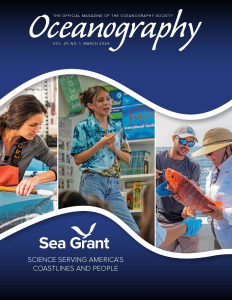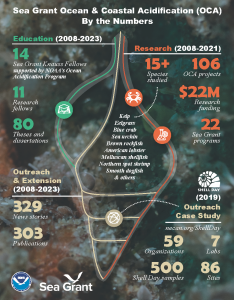The ocean is absorbing carbon dioxide from the atmosphere, leading to lower pH and greater acidity. This is causing a fundamental change in the chemistry of the ocean.
Ocean acidification refers to a change in ocean chemistry in response to the uptake of increasing carbon dioxide in the atmosphere. The ocean is tightly linked with the atmosphere and absorbs huge amounts of carbon dioxide each year. This exchange helps to regulate the planet’s atmospheric concentrations of carbon dioxide, but comes at a cost for the oceans and marine ecosystems, as well as coastal communities and economies (NOAA National Ocean Service).
MIT Sea Grant & Ocean Acidification
MIT Sea Grant addresses issues that impact coastal and marine waters through developing tools, platforms, technologies, and engineering solutions, as well as conducting innovative research to increase the capabilities of decision-makers, industry, and resource managers. Our ocean and coastal acidification work focuses on the following areas:
- Monitoring and modeling
- Sensor development
- Assessing impacts on coastal resources, industries, and economies
- Assisting regional groups with monitoring, analysis, outreach, education, and training
Since 2008, Sea Grant has provided $110M in research funding to further the understanding of ocean acidification and related impacts on coastal communities, economies, fisheries, and ecosystems.
Special Sea Grant Issue of Oceanography
This special issue features 36 articles from over 175 Sea Grant authors covering topics from applied education to ocean acidification, including: Sea Grant Network Contributions to the National Ocean and Coastal Acidification Response, co-authored by Carolina Bastidas.
Funded Ocean & Coastal Acidification Research
MIT Sea Grant provides competitive funding opportunities for Massachusetts-based research scientists who seek to address marine issues in ways that benefit the Commonwealth. Several ocean acidification projects are funded through our Core RFP.
FY2024 Projects
-
Ocean Acidification in Massachusetts and Cape Cod Bay
Ryan Woosley, Massachusetts Institute of Technology · 2/1/2024 – 1/31/2026
-
Investigating the Efficacy of Alkalinity Addition in Mitigating the Effects of Ocean Acidification on Commercial Shellfish
Justin Ries, Northeastern University · 2/1/2024 – 1/31/2026
-
Quantification of Ocean Acidification and Flow Properties in the US North East Coast with Applications to Aquaculture Monitoring and Marine Debris Mitigation
Themistoklis Sapsis, Massachusetts Institute of Technology · 2/1/2024 – 1/31/2026
FY2023 Projects
-
Ocean Acidification in an Intensely Farmed Coastal Bay System
David Ralston, Woods Hole Oceanographic Institution · 2/1/2023 – 1/31/2024 -
Data Driven, Causal Discovery of the Effects of Climate Change, Ocean Acidification and Management in Fish and Invertebrate Stocks
Petros Koumoutsakos, Harvard University · 2/1/2023 – 1/31/2024
FY2021 Projects
-
Multi-Sensor Reconstruction of pH and Temperature in Gulf of Maine
Justin Ries, Northeastern University · 2/1/2021 – 1/31/2023 -
Implementation of Large-Scale Pervasive Ocean Acidity Monitoring Using a Distributed System of Autonomous Mobile Robots
Dick Yue, MIT · 2/1/2021 – 1/31/2023 -
Ecosystem Characterization in the US North East Coast using Big Data and Machine Learning
Themistoklis Sapsis, MIT · 2/1/2021 – 1/31/2023
FY2020 Projects
-
Pervasive Monitoring of Offshore Aquaculture Installations using Moored Profilers
Jeff Dusek, Olin College of Engineering; Co-PI Alessandra Ferzoco, Olin; Co-PI Joanna Carey, Babson College · 02/2020 – 01/2022
FY2019 Projects
-
A New Paradigm for Pervasive and Persistent Monitoring of Ocean Acidity Using a Distributed System of Autonomous Mobile Robots
Dick Yue, MIT · 02/2019 – 01/2021 -
Quantifying Acidification Levels in the US North East Coast via Machine Learning Tools
Themistoklis Sapsis, MIT · 2/2019 – 1/2021 -
Bayesian Intelligent Ocean Modeling and Acidification Prediction Systems
Pierre Lermusiaux, MIT · 2/2019 – 1/2021
FY2018 Projects
-
Quantifying Coastal Ocean Acidification Impacts on Estuarine Nitrogen Removal
Robinson Fulweiler, Boston University · 2/2018 – 1/2020 -
Measuring Acid/Base Chemistry in the Extrapallial Fluids of New England’s Commercially Important Mollusks to Explore their Differential Responses to Ocean Acidification
Justin Ries, Northeastern University · 2/2018 – 1/2022 -
Making Sense of the Variability of Coastal Ocean Acidification: Potential Long-Term Impacts on the Oyster Aquaculture Industry
Robert Chen, University of Massachusetts Boston · 2/2018 – 1/2022
FY2017 Projects
-
Developing a Miniaturized In-situ Sensor Technology for Simultaneous Measurements of Seawater Dissolved Inorganic Carbon and pCO2
Zhaohui Aleck Wang, Woods Hole Oceanographic Institution · 2/2017 – 1/2019 -
Sensors for Measuring Carbon Dioxide, Bicarbonate, and pH in the Ocean
Timothy M. Swager, MIT · 2/2017 – 1/2019 -
Towards a Cost-Effective Monitoring System of Coastal Ocean Acidification in the US North East
Themistoklis Sapsis, MIT · 2/2017 – 1/2019
FY2016 Projects
-
Investigation of the Effects of Ocean Acidification and Warming on the Calcification Rate & Shell Properties of Commercially Important Early Stage New England Mollusks
Justin Ries, Northeastern University · 2/2016 – 1/2018 -
Quantification of the contribution of wastewater effluent to coastal ocean acidification
Scott Doney, Woods Hole Oceanographic Institution · 2/2016 – 8/2018
Meet Our Contact
Dr. Carolina Bastidas’ recent work has contributed towards understanding climate change impacts on coastal ecosystems, particularly how coastal acidification has impacted and will further impact benthic communities such as oyster reefs.
Educational Resources
Here you will find how to implement four hands-on activities in classrooms and other informal education spaces. Each activity is described as it is presented to students, followed by a list of materials and comments that might help educators. These activities have been used at the High School Marine Science Symposium, and the slides provided can be used by educators to guide students through these activities (45 min). Learning goals include defining ocean acidification and identifying two impacts to marine life.
Activity 1 – Breathing: How CO2 is increasing the acidity of the ocean
Activity 2 – Fish Behavior: Biological effects of increasing sea water acidity (with video)
Activity 3 – Wet Shells: How increased acidity affects bivalves and other mollusks, lobsters, and corals
Activity 4 – Shell Detective: Weighing the difference between healthy and acid-treated shells
Please submit the form below to download the resources. For further help with the activities or to discuss an idea you’d like to implement with your audience, please contact Carolina Bastidas: Bastidas@mit.edu.





